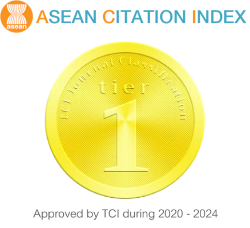เศรษฐศาสตร์การเมืองระหว่างประเทศกับนโยบายการควบคุมยาสูบ: กรณีศึกษาสหภาพยุโรป ฝรั่งเศสและเยอรมนี
คำสำคัญ:
การควบคุมยาสูบ, ระบบอภิบาลสุขภาพ, กรอบอนุสัญญาว่าด้วยการควบคุมยาสูบ พ.ศ. 2546, สหภาพยุโรป, กลไกระดับภูมิภาคบทคัดย่อ
การควบคุมยาสูบเป็นประเด็นหนึ่งในด้านเศรษฐศาสตร์การเมืองระหว่างประเทศ แม้ว่าปัจจุบันจะมีกรอบอนุสัญญาว่าด้วยการควบคุมยาสูบ พ.ศ. 2546 เป็นกลไกในระดับโลกเพื่อควบคุมการระบาดยาสูบ แต่ระดับการควบคุมยาสูบของประเทศยังคงมีความแตกต่างกันเป็นอย่างมาก สาเหตุสำคัญที่ทำให้การควบคุมยาสูบเผชิญกับแรงต้านเป็นเพราะตลาดยาสูบมีการเชื่อมโยงในระดับโลกและสร้างกำไรมหาศาล การศึกษานี้ใช้กรอบทฤษฎีระบบอภิบาลสุขภาพโลกเพื่อเสนอว่ากลไกกรอบอนุสัญญาฯ เพียงอย่างเดียวไม่เพียงพอต่อการพัฒนาการควบคุมยาสูบอย่างมีประสิทธิภาพได้ แต่ต้องใช้ทั้งกลไกในระดับภูมิภาค ตัวแสดงระดับรัฐ และตัวแสดงที่มิใช่รัฐร่วมด้วย งานวิจัยฉบับนี้ใช้กรณีของสหภาพยุโรป ฝรั่งเศส และเยอรมนีเป็นกรณีศึกษา ผลการศึกษาพบว่าฝรั่งเศสที่มีการควบคุมยาสูบอย่างเข้มงวด เนื่องจากตัวแสดงด้านการเมือง ภาคประชาสังคม และบุคลากรการแพทย์มีอิทธิพลสูงในการสนับสนุนการควบคุมยาสูบ สามารถทัดทานอิทธิพลจากบริษัทยาสูบข้ามชาติและผู้ค้าปลีกบุหรี่ได้ ตรงกันข้ามกับเยอรมนีที่มีความล่าช้าในการควบคุมยาสูบเนื่องจากฝ่ายการเมืองไม่สนใจ และภาคประชาสังคมที่ต่อต้านยาสูบมีความอ่อนแอ ประกอบกับบริษัทยาสูบในประเทศและข้ามชาติมีผลประโยชน์ทางเศรษฐกิจและอิทธิพลสูงในการแทรกแซงการพัฒนาการควบคุมยาสูบ อย่างไรก็ดีเมื่อสหภาพยุโรปใช้กลไกด้านกฎหมายของสหภาพยุโรปเพื่อดำเนินการสร้างความกลมกลืนนโยบายควบคุมยาสูบระหว่างประเทศสมาชิกส่งผลให้แต่ละประเทศสมาชิกมีการพัฒนาการควบคุมยาสูบมากขึ้นโดยเฉพาะอย่างยิ่งในกรณีของเยอรมนีที่ต่อต้านการควบคุมยาสูบมาตลอด อีกทั้งมาตรการภาษียังส่งผลดีต่อสุขภาพประชาชน สามารถหลีกเลี่ยงการตายเนื่องจากบุหรี่ได้จำนวนหนึ่ง และทำให้แนวโน้มการบริโภคบุหรี่ของประชากรลดลง อย่างไรก็ตามการสร้างความกลมกลืนด้านภาษียังเคารพหลักการเรื่องมาตรการภาษีจะจำกัดผล กระทบต่อเศรษฐกิจของประเทศสมาชิก สะท้อนได้จากภาษีบุหรี่ยังคงเป็นรายได้ให้แก่ประเทศสมาชิกเช่นเดิม งานวิจัยฉบับนี้เสนอว่าอาเซียนและประเทศสมาชิกสามารถใช้การสร้างความกลมกลืนนโยบายควบคุมยาสูบระหว่างประเทศสมาชิกของสหภาพยุโรปมาปรับใช้เพื่อทำให้เกิดการศึกษาพัฒนาการควบคุมยาสูบระดับอาเซียนรวมถึงประเทศไทยและลดความแตกต่างของนโยบายควบคุมยาสูบระหว่างประเทศสมาชิกอาเซียน
เอกสารอ้างอิง
Chamchan C, Suttikasem K. Global health governance in Thailand. Nakhon Pathom: Institute for Population and Social Research, Mahidol University; 2018. 176 p. (in Thai)
World Health Organization. About the WHO Framework Convention on Tobacco Control [internet]. 2003 [cited 2021 Feb 2]. Available from: https://www.who.int/fctc/about/en.
Grand View Research. Tobacco market size, share & trend analysis report by product (smokeless, cigarettes, cigars & cigarillos, next generation products, waterpipes), by region, and segment forecasts, 2021-2028 [internet]. 2021 Feb [cited 2021 Feb 2]. Available from: https://www.grandviewresearch.com/industry-analysis/tobacco-market.
Joossens L, Raw M. Progress in tobacco control in 30 European countries 2005-2007. Berne: Swiss Cancer League; 2007. p. 1-24.
Reich MR. Political analysis for health. Bulletin of the World Health Organization 2019;97:514.
Kusi-Ampofo O. Negotiating change: ideas, institutions, and political actors in tobacco control policy making in Mauritius. Journal of Health Politics, Policy and Law 2021;46:435-65.
Kingdon J. Agendas, alternatives and public policies. Boston: Little, Brown; 1995.
Chantornvong S, McCargo D. Political economy of tobacco control in Thailand. Tobacco Control 2001;10:48-54.
Bump JP, Reich MR, Adeyi O, Khetrapal S. Towards a political economy of tobacco control in low- and middle-income countries. Washigton DC: The World Bank; 2009. 97 p.
Koplan JP, Bond TC, Merson MH, Reddy K S, Rodriguez MH, Sewankambo NK, et al. Towards a common definition of global health. Lancet 2009;373(9679):1993-5. Available from: https://doi.org/10.1016/S0140-6736(09)60332-9.
de Leeuw E, et al. Emerging theoretical frameworks for global health governance. In: Clavier C, de Leeuw E, editors. Health promotion and policy process. Oxford: Oxford University Press; 2013. p. 231-87.
Studlar D. What explains the paradox of tobacco control policy under federalism in the U.S. and Canada? Comparative Federalism Theory versus Multi-level Governance. Publius: The Journal of Federalism 2010;40(3):389-411.
Hill C, Laplanche A. Cigarette in France: the true figures. Paris: La Documentation française; 2003. 139 p.
République Française. Cancer plan 2003-2007. Paris: Ministry of Health; 2003. 44 p. (in French)
Karsenty S, Hirsch A. Evolutions of cigarette consumption in France from 1999 to 2008. Bulletin Epidémiologique Hebdomadaire 2010;(19-20):214-6. (in French)
République Française. Cancer plan 2009-2013. Paris: Ministry of Health; 2009. (in French)
République Française. National smoking reduction program 2014-2019. Paris: Ministry of Health; 2014. 55 p. (in French)
Reid R. Globalizing tobacco control: anti-smoking campaigns in California, France and Japan. US: Indiana University Press; 2005. 328 p.
La vie des entreprises. Cigarette market in France [internet]. 2017 Jul 24 [cited 2021 Feb 2]. Available from: https://lavde.fr/le-marche-du-tabac-en-france/. (in French)
Braillon A, Mereau AS, Dubois G. Tobacco control policy in France: from war to compromise and collaboration. Tobacco Control and Public Health in Eastern Europe 2012;2(2):59-66.
Elliot R. Inhaling democracy: Cigarette advertising and health education in Post-war West Germany. Social History of Medicine 2015;28(3):509-31.
World Health Organization. European country profiles on tobacco control 2001. Copenhagen: WHO Regional Office; 2002.
Macrotrends. Germany Smoking Rate 2007-2021 [internet]. [cited 2021 Feb 2]. Available from: https://www.macrotrends.net/countries/DEU/germany/smoking-rate-statistics.
Lampert T, Lippe EVD, Müters S. Prevalence of smoking in the adult population of Germany. Bundesgesundheitsbl 2013;56:802–8.
Cooper AH, Kruzer P. Why Germany lags in tobacco control. German Politics and Society 2003;21(3):24-47.
Duina F., Kurzer P. Smoke in your eyes: the struggle over tobacco control in the European Union. Journal of European Public Policy 2004;11(1):57-77.
Grüning T, Strunck C, Gilmore AB. Puffing away? Explaining the politics of tobacco control in Germany. German Politics 2008;17(2):140-64.
Mons U, Pötschke-Langer M. Tobacco control politics in Germany. Evidence, success, and barriers. Bundesgesundheitsblatt, Gesundheitsforschung, Gesundheitsschutz 2010;53(2):144-51.
Kehoe T, Greenhalgh EM. An indispensable luxury: British American tobacco in the occupation of Germany, 1945-1948. Business History 2019;61(8):1326-51.
Grüning T, Weishaar H, Collin J, Gilmore AB. Tobacco industry attempts to influence and use the German government to undermine the WHO Framework Convention on Tobacco Control. Tobacco Control 2012;21(1):30-8.
Reubi D, Berridge V. The internalization of tobacco control 1950-2010. Med Hist. 2016;60(4):453-72.
Feldman EA, Bayer R. The triumph and tragedy of tobacco control: a tale of nine nations. Annual Review of Law and Social Science 2011;7:79-100.
Derek Y, et al. Globalization and tobacco. In: Kawachi I, Wamala S, editors. Globalization and health. Oxford: Oxford University Press; 2007. p. 39-67.
Cairney P, Studlar DP, Mamudu HM. Global tobacco control. London: Palgrave Macmillan; 2012. 284 p.
Joosen L, Raw M. Tobacco control scale: a new scale to measure country activity. Tobacco Control 2006;(15):247-53.
World Health Organization Regional Office for Europe. The European report on tobacco control policy: review of implementation of the Third Action Plan for a Tobacco-free Europe 1997-2001. WHO European Ministerial Conference for a Tobacco-free Europe; 2002 Feb 18-19; Warsaw. Copenhagen: WHO Regional Office for Europe; 2002.
Curie L et al. Policy recommendations for tobacco taxation in the European Union integrated research findings from the PPACTE Project. 147 p.
Joossens L. Tobacco control scale [internet]. [cited 2021 Feb 2]. Available from: https://www.tobaccocontrolscale.org/.
ดาวน์โหลด
เผยแพร่แล้ว
รูปแบบการอ้างอิง
ฉบับ
ประเภทบทความ
สัญญาอนุญาต

อนุญาตภายใต้เงื่อนไข Creative Commons Attribution-NonCommercial-NoDerivatives 4.0 International License.
วารสารวิจัยระบบสาธารณสุขอยู่ภายใต้การอนุญาต Creative Commons Attribution-NonCommercial-NoDerivatives 4.0 International (CC BY-NC-ND 4.0) เว้นแต่จะระบุไว้เป็นอย่างอื่น




